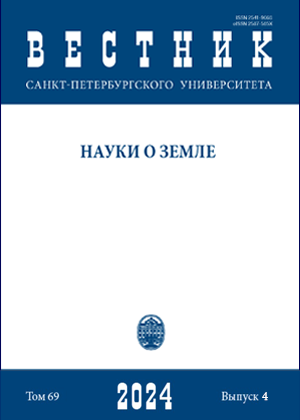Characteristics of tides in the World Ocean according to the Global tidal models
DOI:
https://doi.org/10.21638/spbu07.2024.408Abstract
The article presents numerical characteristics of the spatial distribution of type and height of tides in the World Ocean according to the data of three global tidal models: EOT20, FES2014 and TPXO9. To obtain these estimates, a preliminary comparison of methods of determining tidal types was carried out. An algorithm for quickly pre-calculating tide heights for a long period of time for a grid area covering the entire World Ocean was also developed. Moreover, a method for calculating the probability density function of the spatial distribution of tidal characteristics was implemented. The characteristics of the tide were determined both in the entire World Ocean and in individual oceans. In addition, estimates of changes in tide characteristics depending on latitude, distance to the coast and sea depth were obtained. Mean, median and mode values of tidal heights and types were calculated. Our results showed that the main patterns of distribution of tidal characteristics remain unchanged regardless of the chosen global tidal model. It was revealed that the semidiurnal type of tide dominates over the entire area of the World Ocean. The distribution of frequencies of occurrence of various heights in the World Ocean and in its individual parts has been determined for the first time. It has been established that the probability density function of tide heights has a single-mode distribution with positive skewness. The most common are average tidal heights equal to 0.6 m and extreme tidal heights equal to 0.9 m. The dependence of the characteristics of tides on latitude is most clearly manifested. Nevertheless, this dependence is not symmetrical relative to the equator. The spatial distribution of tidal types does not depend on sea depth and distance to the coast, while tide heights decrease with distance from the mainland.
Keywords:
tides, global tidal models, type of tide, height of tide
Downloads
References
Богданов, К. Т. и Магарик, В. А. (1967). Численное решение задачи о распространении приливных волн (М2 и S2) в Мировом океане. Доклады АН СССР, 172 (6), 1315–1317.
Владимирский, Н. П. и Стахевич, В. С. (1941). Руководство по обработке и предсказанию приливов. Л.: Изд-во Гидрограф. упр. ВМФ СССР.
Войнов, Г. Н. (2019). Общая характеристика приливов на основе новых значений гармонических постоянных в Финском заливе. Ученые записки РГГМУ, 56, 81–97. https://doi.org/10.33933/2074-2762-2019-56-81-97
Дуванин, А. И. (1960). Приливы в море. Л.: Гидрометеоиздат.
Марчук, Г. И. и Каган, Б. А. (1991). Динамика океанских приливов. Л.: Гидрометеоиздат.
Тирон, К. Д., Сергеев, Ю. Н., Мичурин, А. Н. (1967). Карта приливов Тихого, Атлантического и Индийского океанов. Вестник ЛГУ, 24, 123–135.
Courtier, A. (1938). Classification of tides in four types. In: Conferenes sur les Marees. Paris: Service Hydrographique de la Marine Francaise.
Egbert, G. D. and Erofeeva, S. Y. (2002). Efficient inverse modeling of barotropic ocean tides. Journal of Atmospheric and Oceanic Technology, 19 (2), 183–204. https://doi.org/10.1175/1520-0426(2002)019<0183:EIMOBO>2.0.CO;2
Fu, Y., Feng, Y., Zhou, D. (2020). Accuracy assessment of global ocean tide models in the South China Sea using satellite altimeter and tide gauge data. Acta Oceanologica Sinica, 39 (12), 1–10. https://doi.org/10.1007/s13131-020-1685-y
Gerkema, T. (2019). An introduction to tides. Cambridge: Cambridge University Press. https://doi.org/10.1017/9781316998793
Hart-Davis, M. G., Piccioni, G., Dettmering, D. (2021). EOT20: A global ocean tide model from multi-mission satellite altimetry. Earth System Science, 13, 3869–3884. https://doi.org/10.5194/essd-13-3869-2021
IHO (1953). Limits of Oceans and Seas, special publication. Special Publication No. 28. 3rd ed. Monte-Carlo: International Hydrographic Organization.
Lee, S. H. and Chang, Y. S. (2019). Classification of the global tidal types based on auto-correlation analysis. Ocean Science, 54 (2), 279–286. https://doi.org/10.1007/s12601-019-0009-7
Lyard, F. H., Allain, D. J., Cancet, M., Carrere, L., Picot, N. (2021). FES2014 global ocean tide atlas: Design and performance. Ocean Science, 17, 615–649. https://doi.org/10.5194/os-17-615-2021
Matthews, J. B. and Matthews, J. B. R. (2014). Physics of climate change: harmonic and exponential processes from in situ ocean time series observations show rapid asymmetric warming. Advanced Physics, 2, 1137–1171. https://doi.org/10.24297/jap.v6i2.6960
Oreiro, F. A., D’Onofrio, E., Grismeyer, W., Fiore, M., Saraceno, M. (2014). Comparison of tide model outputs for the northern region of the Antarctic Peninsula using satellite altimeters and tide gauge data. Polar Science, 8, 10–23. https://doi.org/10.1016/j.polar.2013.12.001
Schwiderski, E. W. (1980a). Ocean tides, II, a hydrodynamic interpolation model. Marine Geodesy, 3, 219–255. https://doi.org/10.1080/01490418009387998
Schwiderski, E. W. (1980b). On Charting Global Ocean Tides. Reviews of Geophysics, 18 (1), 243–268. https://doi.org/10.1029/RG018i001p00243
Seifi, F., Deng, X., Andersen, O. B. (2019). Assessment of the Accuracy of Recent Empirical and Assimilated Tidal Models for the Great Barrier Reef, Australia, Using Satellite and Coastal Data. Remote Sensing, 11, 1211–1240. https://doi.org/10.3390/rs11101211
Stammer, D., Ray, R. D., Andersen, O. B. (2014). Accuracy assessment of global barotropic ocean tide models. Reviews of Geophysics, 52, 243–282. https://doi.org/10.1002/2014RG000450
Stok, van Der J. P. (1897). Wind and weather, currents, tides and tidal streams in the East Indian Archipelago. Batavia: Government Printing Office.
Sun, W., Zhou, X., Zhou, D., Sun, Y. (2022). Advances and Accuracy Assessment of Ocean Tide Models in the Antarctic Ocean. Frontiers in Earth Science, 10, 3389–3403. https://doi.org/10.3389/feart.2022.757821
Ueno, T. (1964). Theoretical studies on tidal waves travelling over the rotating globe. Oceanography Magazine, 15 (2), 99–101.
Downloads
Published
How to Cite
Issue
Section
License
Articles of "Vestnik of Saint Petersburg University. Earth Sciences" are open access distributed under the terms of the License Agreement with Saint Petersburg State University, which permits to the authors unrestricted distribution and self-archiving free of charge.






